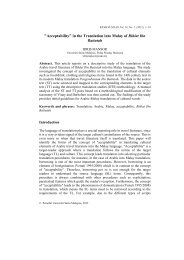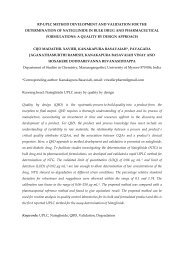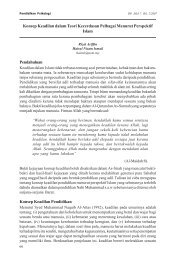Isolation, Identification and Molecular Characterization of Rare - USM
Isolation, Identification and Molecular Characterization of Rare - USM
Isolation, Identification and Molecular Characterization of Rare - USM
You also want an ePaper? Increase the reach of your titles
YUMPU automatically turns print PDFs into web optimized ePapers that Google loves.
Mal. J. Microbiol. Vol 8(2) 2012, pp. 83-91<br />
Table 2: Differential characteristics <strong>of</strong> strain VUK-10 <strong>and</strong> type strains <strong>of</strong> closely related Pseudonocardia species. Strain<br />
VUK-10 (Data from the study). P. endophytica YIM 56035 (Data obtained from study Hua et al., 2009). P.kongjuensis<br />
DSM 44525 (Data obtained from Hua et al., 2009). P.ammonioxydans H9 (data obtained from Liu et al., 2006). (+) -<br />
Positive or Present; (W) weakly positive; (-) – Negative; ND- No data available<br />
CHARACTER RESPONSE<br />
Morphological Characters<br />
S No Characteristics under VUK-10 P. endophytica P. kongjuensis P. ammonioxydans<br />
study<br />
YIM 56035 DSM 44525 H9<br />
1 Sporophore<br />
Fragmentation Fragmentation Fragmentation Fragmentation<br />
morphology<br />
2 Color <strong>of</strong> aerial<br />
Creamy white White White White<br />
mycelium<br />
3 Color <strong>of</strong> substrate Brownish Yellowish-brown Yellowish- Brown<br />
mycelium<br />
orange<br />
Physiological Characters<br />
brown<br />
4 Gram reaction +, aerobic +, aerobic +, aerobic +, aerobic<br />
5 Acid-fast reaction<br />
6 Production <strong>of</strong> melanin<br />
pigment<br />
7 Production <strong>of</strong> Diffusible<br />
pigment<br />
8 Range <strong>of</strong> temperature<br />
for growth<br />
9 Optimum temperature<br />
for growth<br />
10 Range <strong>of</strong> pH for growth<br />
11 Optimum ph for growth<br />
12 NaCl Tolerance<br />
13 Optimum NaCl<br />
Concentration<br />
14 Catalase production<br />
15 Urease production<br />
16 Hydrogen sulfide<br />
production<br />
17 Nitrate reduction<br />
18 Starch hydrolysis<br />
19 Gelatin liquefaction<br />
20 Methyl red test<br />
21 Vogues-proskauer test<br />
22 Indole production<br />
23 Citrate utilization<br />
24 Casein hydrolysis<br />
<strong>Molecular</strong> <strong>Characterization</strong><br />
Analysis <strong>of</strong> the 16s rDNA gene sequence <strong>of</strong> the strain<br />
vuk-10<br />
The 16S rDNA sequence data supported the assignment<br />
<strong>of</strong> this isolate VUK-10 to the genus Pseudonocardia <strong>and</strong><br />
species endophytica (Pseudonocardia endophytica). The<br />
800 bp partial 16S rDNA sequence <strong>of</strong> the strain VUK10<br />
was obtained <strong>and</strong> submitted to the GenBank database<br />
under an accession number JN087501. The partial<br />
sequence was aligned <strong>and</strong> compared with all the 16S<br />
rRNA gene sequence available in the GenBank database<br />
by using the multisequence advanced BLAST comparison<br />
- ND - ND<br />
+ - - -<br />
- - - -<br />
25-50 ºC 15-37 ºC 4-37 ºC 10-40 ºC<br />
30 ºC 28 ºC ND ND<br />
5-9 6-8 ND ND<br />
7 ND ND ND<br />
10 % 5 % 7 % 8 %<br />
3 % 1 % ND 3.5 %<br />
+<br />
Biochemical Characters<br />
+ + +<br />
- - + +<br />
- - + +<br />
- - - +<br />
- - - W<br />
- - - W<br />
- ND ND ND<br />
- ND ND ND<br />
- ND ND ND<br />
+ ND ND ND<br />
- - + +<br />
tool that is available in the website <strong>of</strong> National Centre for<br />
Biotechnology Information. The highest 16S rRNA<br />
sequence similarity value <strong>of</strong> 98% was obtained for the<br />
Pseudonocardia endophytica 16s rRNA (GenBank<br />
accession no: DQ887489) (Frederic et al., 1999). The<br />
phylogenetic analysis <strong>of</strong> the 16S rRNA gene sequence<br />
was aligned using the CLUSTAL W programme from the<br />
MEGA 5 Version. Phylogenetic tree was constructed<br />
using <strong>Molecular</strong> Evolutionary Genetics Analysis (MEGA)<br />
s<strong>of</strong>tware Version 5 using Maximum parsimony method<br />
(Saitou <strong>and</strong> Nei, 1987; Takahashi <strong>and</strong> Nei, 2000; Tamura<br />
et al., 2007, 2011). The topologies <strong>of</strong> the constructed tree<br />
were evaluated by bootstrap analysis with 1000<br />
resamplings by Maximum parsimony tool. Sequence<br />
comparison <strong>of</strong> the strain VUK-10 with the corresponding<br />
87 ISSN (print): 1823-8262, ISSN (online): 2231-7538


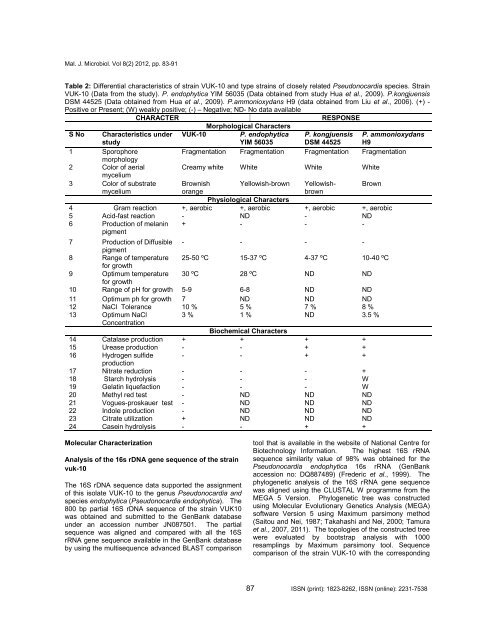

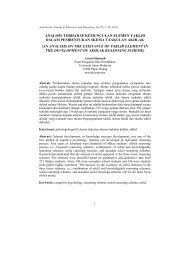
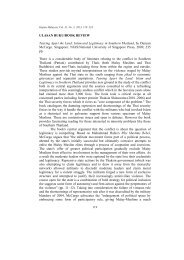

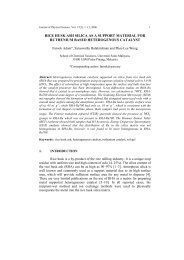

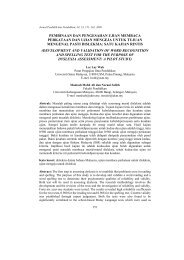
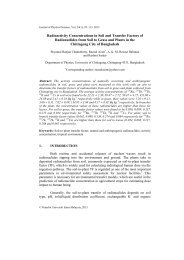
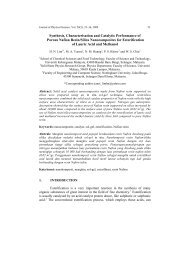

![KTT 111 – Inorganic Chemistry I [Kimia Takorganik I] - USM](https://img.yumpu.com/12405642/1/184x260/ktt-111-inorganic-chemistry-i-kimia-takorganik-i-usm.jpg?quality=85)
